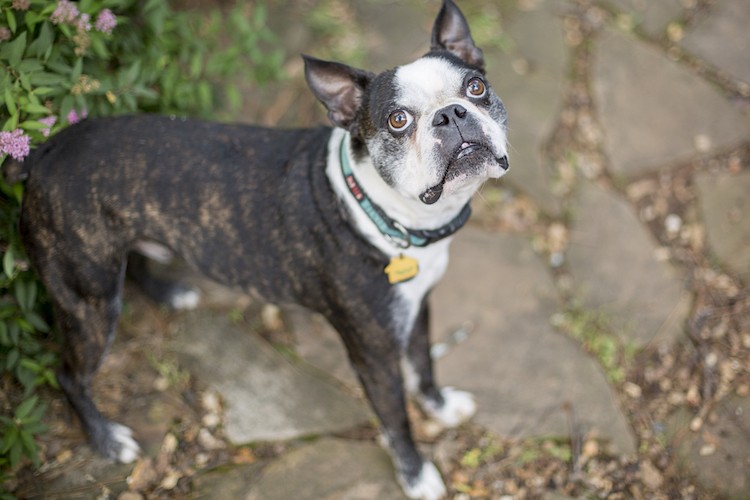Oh, Otis.
My dog might be a jerk.
Don’t misunderstand. I love him with all my heart. Most days, he’s my adorable goof that is easy, sweet, and happy-go-lucky. But he can be a little bit of a handful. Before I could successfully bring in foster dogs with any regularity, I needed to understand and meet the needs of my dog, first.
It can be hard to introduce a foster dog to your dog.
Disclosure: This post contains affiliate links. As an affiliate, I earn a commission on qualifying purchases made through these links, at no additional cost to you. I only recommend products I use and love or plan to purchase myself.
Otis isn’t the ideal pet for fostering dogs.
I don’t have that wonderful, social dog that loves all dogs and can’t wait to run and play with a new friend. I have a dog that is unsure, fears the worst in an unfamiliar dog, and who doesn’t really like to share his things. It makes it hard to foster.
Otis is an instigator. The fun police. And a huge dose of Deputy Barney Fife. He “forgets” (aka disregards) regularly that I’m the manager of his environment. I’m responsible for protecting him.
He can be kerfuffled by the unpredictable.
About twice a week, he approaches the privacy fence and says, “neener, neener, neener!” to the neighbor’s lab/hound mix so as to get that dog riled up and exhaling deep, braying barks as he pounces on the fence. This ignites a chorus of barks from the rest of the neighborhood dogs. Satisfied with the mayhem, Otis runs away from the fence as if no one saw him do it. The dog next door weighs 80 lbs or more. I’m amazed my fence is still standing.
As I call Otis away from his mischief, he responds fairly well, running directly toward me in a perfect recall. At the last minute, he hangs a right, cutting his eyes at me as he flies past in a full sprint as if daring chase.
I choose to secretly laugh at his proud attempts to escape my kind authority.
He’s willful. I ask him to sit over here, and sometimes he’s going to try and see if I’ll be OK with him sitting over there. I’m not ok with it, reward withheld, but he tries anyway.
His behavior is able to be improved, and I’ve been a lazy trainer of late. I own that.
He went to greet the dog statue at the dog park and muzzle-punched it instead. I’m not sure if he was threatening the statue or if this was some clumsy attempt to invite play, but it’s not desirable behavior. He has no dog park privileges when the park is occupied.
Last week, Otis and I were out for a walk, and we came upon a toddler trying out his new Fred Flintstone style toy car in the family’s driveway. The car made noise, the child made noise, and Otis was highly distracted by this new noisy thing in HIS neighborhood. We stopped for a minute (on the other side of the street) so Otis could process what he was seeing, then I encouraged a continuation of our stroll around the neighborhood.
Otis’s social behavior is rooted in anxiety.
I learned long ago that I have no real influence on when and how my dog feels anxiety in his environment. I cannot make him NOT feel anxiety, that would make me magical. My job is to manage his environment while I help him think through his anxiety so he can make different choices.
Over time, Otis and I have worked out a system where I can introduce a foster dog to him in a way that is comfortable for everyone.
Introducing a foster dog to my dog, Otis
New dogs always worry Otis. Given the opportunity, he’s going to act a bully before the other dog is given the chance to make a wrong move. Otis assumes the worst and wants to be in charge of the scene, two steps ahead of his opposer, just in case.
For this reason, I delay plans to introduce a foster dog to Otis.
It takes Otis about three days to relax with a new foster dog in the house. And because I know he can be rude, I keep the new foster separate from Otis until I see Otis relax and become less worried.
Baby Gates Allow Decompression Before Introductions Between A Foster Dog and Your Dog
I use baby gates. Everywhere. Sometimes, I even put an extra layer between two dogs by adding X-Pen Panels.
My favorite baby gate is the Regalo Easy Step Walk-Through Extra Tall Baby Gate.
Foster dogs are set up in a room adjacent to the main living space: They can see and hear and smell. There is a tall, 42″ baby gate closing off the foster’s room from the main areas. After a period of quiet for everyone, Otis is given free rein and can approach the gate at will. So can the foster dog.
Otis walks to the baby gate, peers through, then maybe gets nose-to-nose if the foster dog is receptive. I interrupt if the nose-to-nose goes on too long. Otis will also look over at me, my cue that he’s needing me to be a part of this process. (I’m ALWAYS present when Otis has access to the baby gate.) I tell Otis, “That’s so-and-so, it’s OK.” He walks away or I call him away. Then, I reward his decision to be neutral.
He may do this a half dozen times in an hour or so, seeking validation from me and making sure this strange creature isn’t a dog of ill-will. My response to Otis is always the same: relaxed, confident, reassuring, and unflapped by this intruder.
If Otis becomes rude at the baby gate, I call him away and move him to another room to give him time away from the new dog. He cannot be a bully at the front line, it’s against the rules. Later, we try again.
If both dogs become rude, I add x-pen panels (usually 3 panels attached with rods) and create a space where the dogs can still see each other but not get nose-to-nose.
If I didn’t have the baby gate in place, Otis would most definitely instigate a dare – either by growling or one of his rude muzzle punches or jowl grabs.
Why have a foster dog experience all that nonsense on their first moments in my house?
During these pre-introduction days, Otis does spend time in his crate and the foster dog is allowed freedom of movement in the social spaces of the house. Otis sees that I am going to allow this newbie to get many of the same freedoms and rewards as he.
As I see Otis relax, I begin to arrange brief periods of time where both dogs are free in the same room. Otis is usually wearing a harness and leash. He still is at risk of a misstep. I’m not strong-arming Otis, I’m allowing him to settle his anxiety on his own timeline while at the same time maintaining leadership and safety.
I’ve had 35 dogs in foster care since I adopted Otis. This is the routine that Otis needs and it works for him. If there’s a dog that Otis just isn’t going to get along with, we live with separation and alternating routines. If both dogs are jerks, both are jerks. Neither dog needs to put up with another dog’s shit. I’m not going to have a foster dog experience unfair treatment, and I’m not going to ruin my dog by making him hang around a dog that doesn’t like him.
Don’t ruin a good dog by having them continually experience rude behavior from another.
I say I carefully choose the dogs that come into my foster home, but that’s not true. Otis likes young puppies, so I foster puppies. I also foster dogs with heartworm because they need more crate rest and less freedom. But I’ll foster any dog for a few weeks, I’m diligent about keeping dogs on a schedule, especially those first critical days, and I use downtime in crates religiously. It’s extra work for me, but I’m able to maintain routine, safety, training, and supervised socialization to optimize my foster dog’s time with me.
Otis has improved over time, too. A recent foster dog became Otis’ playmate. I’ve never, EVER seen Otis play tug games before. Not even with me. It was really good to see him experience social play with another dog. He is recovering from whatever his past dealt him, in part through me asking him to deal with my need to foster.
Most people introduce their new foster dog to their personal dog with an activity such as a parallel leash walk on neutral territory. It’s my goal for Otis to be able to introduce that way. Others have success with more gutsier introductions that I don’t have the chutzpah to try. I’d rather take things slow and facilitate positive experiences than hurry introductions and risk a scuffle – or worse!
How do you introduce foster dogs to your pets?
Popular Posts
- HOW TO CHOOSE A DOG RESCUE AGENCY
- ULTIMATE GUIDE TO FOSTERING: 10 SKILLS YOU NEED
- VOLUNTEER IF YOU CANNOT FOSTER
Content: ©2021 • Pooch On A Couch • All rights reserved
Photography: ©2021 • RJ Hire • All rights reserved




